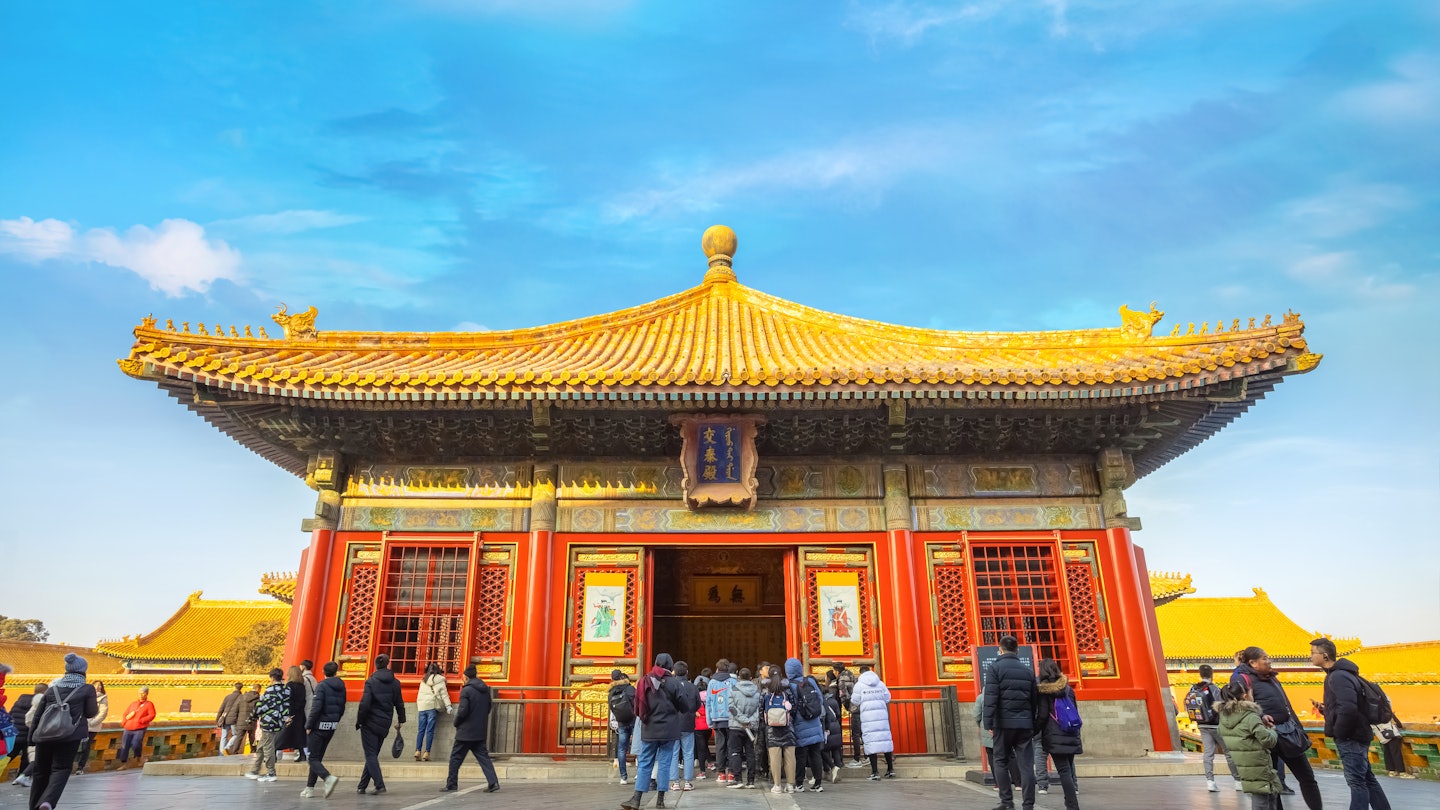

People visiting the Jiaotaidian (Hall of Union) in Beijing. cowardlion/Shutterstock
We know it's easy to feel overwhelmed by the thought of navigating a city the size of Beijing, with a population over 22 million (and quickly rising).
On top of the size and chaotic energy, the language barrier can also pose challenges for non-Chinese speakers learning how to navigate Beijing. The good news is that Beijing is a safe city, and it's tourist-friendly too. Plus you'll find plenty of signage to go with a fast, cheap and efficient transport system.
Getting to your destination can be a breeze if you learn a few things ahead of time about your Beijing transportation options. Read on for our top Beijing travel tips to help you find your way around this behemoth of a city.

Navigating Beijing on foot
Beijing is a vast, sprawling city, so it's not somewhere you'd necessarily describe as imminently walkable. That said, some of the more central areas of Beijing are made for walking and offer a priceless opportunity to engage in everyday local life. Getting lost among a labyrinth of hutongs, or narrow alleyways, is a quintessential Beijing experience, for example. If you want a deeper dive, sign up for a half-day walking tour with a reputable travel outfit such as Bespoke Travel Company.
Top tip: Given that Google Maps is blocked in China, Apple's Maps option is a good choice for navigating Beijing's streets.

Getting around Beijing by subway
Whether you're speeding in from the airport or taking short jaunts across town, the city's modern subway is a fast and convenient means of Beijing public transport for tourists. Comprising 27 lines, it's the world's second-largest subway (behind Shanghai), and links up with all of Beijing's premier attractions, as well as both of its airports.
Fares range from ¥3 (US$.41) to ¥8 (US$1.09), depending on distance. It's the world's busiest subway, so expect things to get crowded (especially during morning and evening peak-hour rush). Bear in mind that traversing Beijing's subway can involve a fair bit of walking – and even more so if you choose the wrong exit. Trains run approximately 5am to 11pm.
Top tip: The subway website has a trip planner, and you can choose from several apps that offer a useful, interactive subway map.

Exploring Beijing by bike
With its expansive network of dedicated bike lanes and flat roads, Beijing is a great city to explore on two wheels. Its bike culture stems from decades gone by, when it was known as "the Bicycle Kingdom" – a time when cyclists took to the streets en masse in Mao suits rather than Lycra, just prior to cars and subways becoming the predominant modes of travel. Now we're seeing a new wave of cyclists hit the streets, a trend brought on by the rise of bike-sharing schemes combined with surging petrol prices and subway shutdowns during Covid.
Dockless bike-share apps come and go, but current options include Didi Bike, Hellobike and Meituan. Expect to pay around ¥1.5 (US$.20) to ¥2 (US$.27) per 30 minutes. To rent a bike, you'll need a smartphone with a local SIM to download the app (only available in Chinese), and then you'll need to register using your passport, as well as either WeChat Pay or Alipay for payment. If you have difficulties, staff at your hotel or hostel can assist, or help you find a bike elsewhere.
Top tip: Be sure to check brakes, pedals and seats before choosing your bike, and always wear a helmet.
Using taxis and rideshare in Beijing
Those preferring the comfort and convenience of taxis or rideshare apps will be pleased to hear that it's a pretty affordable option in Beijing. However, the drawback is that you'll have to put up with Beijing's notorious traffic, and good luck trying to find one if it's raining!
Didi is the local version of Uber – slightly cheaper than taxis and very handy if you have a smartphone with data.
The fixed fare for taxis is ¥13 (US$1.77) for the first 3km and ¥2.3 (US$.31) per kilometer after that; rates are slightly higher after 11pm. Be sure they use the meter; otherwise, find another taxi. A taxi to the airport will cost ¥90 (US$12.28) to ¥140 (US$19.11) to the city center (40 minutes to one hour), and is about ¥200 (US$27.30) to Daxing Airport for the one-hour ride.
Top tip: For non-Chinese speakers, it's best to bring the name and address of your destination in Chinese characters, and likewise your hotel's business card to find your way home again.
Busing around Beijing
Buses are a good option, both for those who like their experiences distinctly local and those who prefer to be able to actually see the city – unlike when traveling on the subway. It's cheap (¥2 [US$.27]; half price with travel card) and foreigner-friendly with multilingual announcements and signs, but it's slower and more challenging for working out where you're going. Buses also run to both of Beijing's airports.
Top tip: Beijing's sightseeing buses (1 and 2; colored brown) do clockwise circuits of the Forbidden City, looping south to Qiánmén via Tian'anmen Square and the Temple of Heaven (¥15 [US$2.04] per ride, ¥10 [US$1.36] with a travel card). An added bonus is that it's like having a Beijing travel guide.
Opt for a driver and a car
International driving permits aren't recognized in China, which pretty much rules out car rentals for most foreign tourists.
Top tip: Hiring a car with driver or taxi for the day is about the same price as renting a car and a good option for those wanting to do day trips to the Great Wall or elsewhere in Beijing.

Ride in a rickshaw
Other means of getting around Beijing are more touristy, like the rickshaws that'll zip you around Houhai Lake and the surrounding hutongs (one hour per person ¥100 [US$13.65]). You'll also find petrol- or battery-powered rickshaws that hang around major tourist sights and nightlife spots looking for fares, but they're more expensive than taxis.
Travel passes
If you're using public transport, Beijing's travel card (deposit ¥20 [$2.73]) is an essential purchase, available at any of the subway stations or larger bus stations. You can recharge them at most (but not all) subway stations and bus station ticket kiosks.
Accessible transport in Beijing
Things are improving for travelers with disabilities in Beijing, but there's still a long way to go. Though many sights have ramps, and subway stations have level-access platforms and elevators or stair lifts inside – especially following both the 2008 and 2022 Paralympic Games – not all are fully accessible. An increasing number of Beijing city buses are wheelchair-accessible with a ramp provided at the rear door, but otherwise, taxis will be your best way of getting around.













